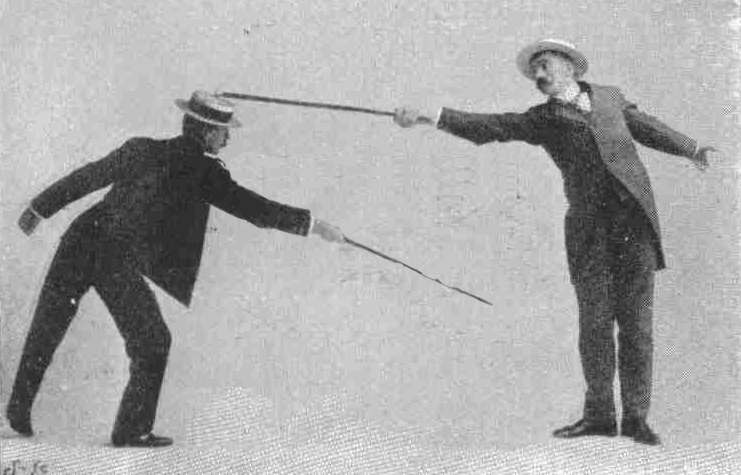- Originally published on the Bartitsu.org site on Thursday, 20th October 2016
Captain F.C. Laing’s 1902 article The ‘Bartitsu’ Method of Self Defence is an often-neglected resource for canonical Bartitsu stick training.
As with all choreographed set-plays, Laing’s “examples” are best approached as formalised representations of certain technical and tactical options. It would be naive to assume that, for example, an active, aggressive opponent would allow any given action by the defender to take effect without attempting to defend and counter it, let alone that any set sequence of techniques could be relied upon in the chaos of a real fight. Thus, Barton-Wright’s precept of adaptability should be taken into account in all set-play training:
It is quite unnecessary to try and get your opponent into any particular position, as this system embraces every possible eventuality and your defence and counter-attack must be based entirely upon the actions of your opponent.
Bearing that principle in mind, the practice of set-plays offers four significant advantages.
1) Given that Bartitsu was effectively abandoned as a work-in-progress during 1902 and that no complete traditional curriculum exists, preserving the canonical set-plays constitutes our strongest practical link back to the first generation of Bartitsu practitioners.
2) Mastery of the set-plays as formal exercises conveys many of the essential, fundamental technical and tactical elements of Bartitsu as a martial art.
3) The set-plays can be “brought to life” via the addition of Bartitsu Club lineage material, as detailed in the second volume of the Bartitsu Compendium, and via combat improvisation training. Numerous failure drills and other exercises introducing progressive elements of spontaneity and active resistence may be applied to any set-play, offering a bridge between martial choreography and free sparring/fighting.
4) The canon of formal set-plays offer a “common language” for modern Bartitsu practitioners, which is especially useful when training with people from different clubs.
Here is an interpretation of Captain Laing’s “First Example” of Bartitsu stick fighting, which he described but did not illustrate in his article:
First.–We will suppose you are attacked by a man also with a
stick in his hand; in nine cases out of ten a man who doesn’t know “Bartitsu” will rush with stick uplifted to hit you over the head.Assume “first position,” guard head, then, before he has time to recover himself, hit him rapidly on both sides of his face, disengaging between each blow as explained, the rapidity of these blows will generally be sufficient to disconcert him; the moment you see this; dash in and hit him in the throat with the butt end of your stick, jump back at once and as you jump hit him again over the head.







